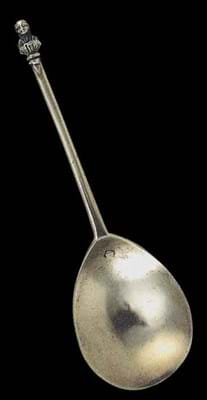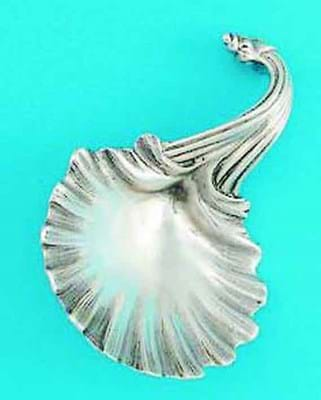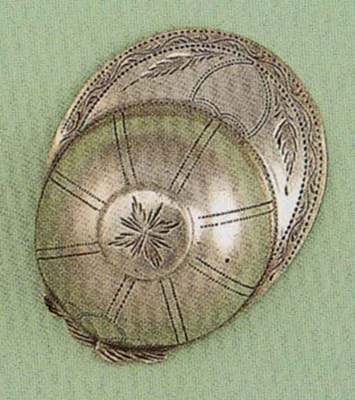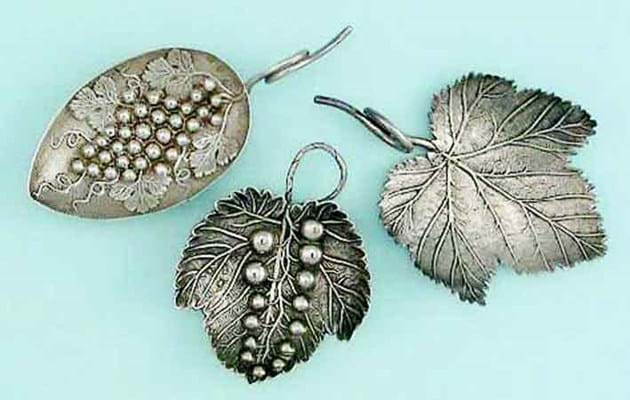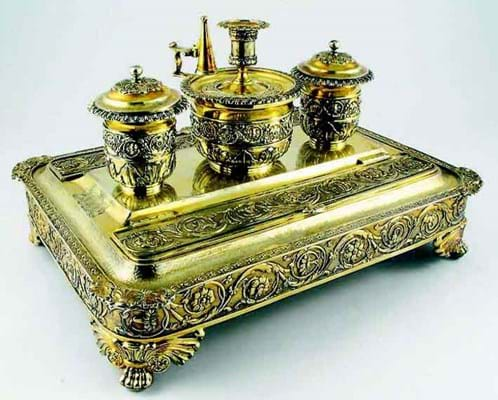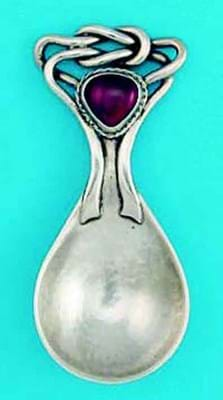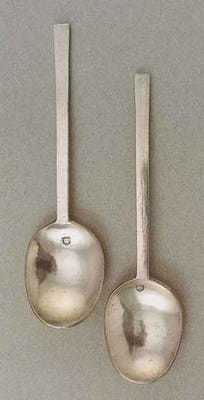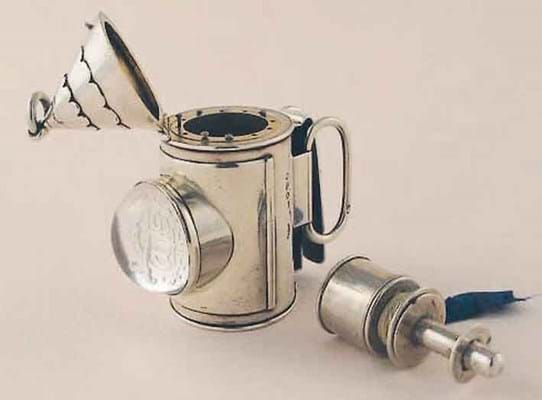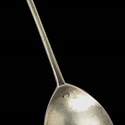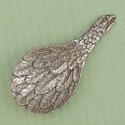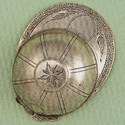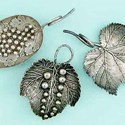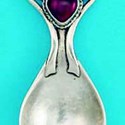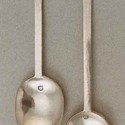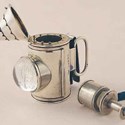But, like the legendary silver dealer Mrs G.E.P How who died earlier this year, he was one of a pioneering generation of connoisseurs to collect and appreciate spoons from an academic viewpoint. He became president of the Caddy Spoon Society and in 1988 penned Caddy Spoons, An Illustrated Guide.
A burgeoning body of scholarship by enthusiasts like John Norie and dealer scholars like Mrs G.E.P. How (who,together with her husband, wrote the seminal three-volume English and Scottish Silver Spoons and Pre Elizabethan Hallmarks on English Plate published 1952-57) helped to heighten interest in this niche market.
But it has been the gradual shift in taste in recent decades from traditional silver fare to smaller, more collectable, works and novelty entries which has led to spiralling prices for spoons.
"A good caddy spoon these days will make £4000-5000 which is more than you would get for a silver canteen and tea service combined," said Woolley & Wallis specialist Alexis Butcher.
Two sales
John Norie's extensive caddy spoon collection dispersed by the Wiltshire auctioneers boasted scores of unusual examples. The lion's share of the holding was 18th and 19th century silver spoons, although there were also mother-of-pearl, tortoiseshell, horn and Tunbridgeware examples. The first part of his eagerly anticipated dispersal was sold in a 253-lot sale back in April, with the second 253-lot tranche offered here in a single-owner sale that preceded their 1189-lot mixed-owner silver and jewellery outing.
Although this dispersal fielded a larger number of damaged and mediocre spoons and mixed lots of routine pieces than the first, there were no casualties. The sale added a further £93,000 to the £122,000 tally taken in April.
While it was no surprise that all 253 lots sold, Mr Butcher had not anticipated some of the punchy prices for damaged spoons.
"A damaged rare spoon is typically only worth one quarter of its value in good condition," he said. "But this sale was people's last chance to buy something from his collection.
The collection's provenance added to its value." The strong presence of Caddy Spoon Society members, several UK dealers in small silverware buying on behalf of clients as well as for stock, and interest from America and Japan ensured a busy day. But a major factor in the sale's success were the reasonable estimates which gave collectors the opportunity to buy some spoons for less than £100.
"You have to tailor caddy spoons to the collectors' market and we were happy to do that," said Mr Butcher. "The bigger London houses are often constricted by minimum values of £200, or sometimes even £500, per lot," Buyers paid a premium for unusual spoons or those by in-demand makers like Omar Ramsden, two of whose spoons with hammered bowls and knotted tendril stems headlined the collection, both eclipsing their £800-1000 estimates. The most expensive entry, decorated with a crimson enamelled boss and dated to 1919, took £3300 while the second spoon, a 1935 piece with pale green chalcedony bosses took £2100.
The presence of two spoons by the Arts and Crafts icon may have capped bidding on each to some extent.The same was true of two highly collectable 'eagle's wing' spoons by Joseph Wilmore - the 1834 example going at £1650 and the 1814 spoon at £1550.
"If there had been just one in the collection it could have made around £3000," said Mr Butcher. Certainly examples have made this sort of sum in the past.
Other contested works by well known makers included an 1853 asymmetrical scroll handle spoon with shell terminal and scallop bowl by John S. Hunt, which went way over estimate at £1250, and an 1838 spoon with a fluted bowl and shell terminal by Charles Fox II which fetched £860.
The strength of Scottish provincial silver in general was echoed here with caddy spoon enthusiasts vying with silver collectors. Of note were a group of three spoons, one with a luckenbooth stem by Fergus & MacBean, which took £700 and a fiddle spoon by James Stobie of Perth which fetched £520.
Other rarities from the collection included eight assorted carved early 19th century mother-of-pearl spoons at £720 (estimate £100-150), and a set of three American spoons, two by Tiffany & Co. which attracted American interest and sold at £720.
Specialist collectors may have sheltered caddy spoons from the troubles besetting other areas of the silver market but Mr Butcher felt there were signs of renewed buying confidence among dealers at the general sale that followed the collection.
The star of the silver was an exquisite George III silver gilt inkstand by John Houle commissioned for the phenomenally wealthy William Harry Vane (1766-1842), the first Duke of Cleveland, whose estate and personal assets were valued well in excess of £2m.
A well-known sportsman and patron of the turf, the extravagant peer famously had his wine glasses made without a foot, obliging dinner guests to drink whole glasses at a time."You would have had to have been someone of serious standing and great wealth to commission this," enthused Woolley & Wallis specialist Alexis Butcher. "Each detachable piece was engraved with the crest and coronet, even the snuffer."
Consigned by a private vendor, the lavish 121/2 x 93/4in (32 x 25cm) inkstand was dated 1817 and weighed 97oz. It was cast with large winged paw feet and had a cast frieze of repeating floral scrolls around the sides. It attracted considerable interest from dealers, some bidding on behalf of private clients, and it eclipsed its £8000-10,000 estimate selling at £21,000.
The activity at lower price levels also pleased Mr Butcher. "When you have so many lots and such a diverse body of material, typically we would have a much lower selling rate by lot especially given the large numbers of wine labels and snuffboxes," he said. "Here, one American dealer was very keen to buy because he said he had sold around 400 objects in recent months." Unusual entries included a 1685 miniature toy mug by George Manjoy with a bulbous reeded neck and coiled scroll handle.The brevity of James II's four-year reign made it a target for one specialist buyer who pursued it to £1300.
Among the wine labels, a rare Cape Madeira narrow rectangular label by George Knight, 1819, fetched £760. Other notable sales included a set of six George III cluster- column loaded candlesticks by John Carter, London 1771 at £8200 and an elegant 14oz George I bullet teapot by John Edwards, London 1726 at £5200.
However, once again, it was the spoon section that included some of the most hotly contested lots and a punchy £6800 was tendered by a collector for a 1540 Henry VIII Maidenhead spoon.
"It is ten times as difficult to find a Henry VIII spoon as it is to find an early Elizabethan example," said Mr Butcher. "If its condition had been nine out of ten rather than seven out of ten it could have made £10,000-15,000."
Also of note was a pair of c.1659 Commonwealth notched Puritan spoons by either Anthony or Joseph Arden of Sherborne that fetched £5200.
Spoons aside, buyers also paid a premium for novelty silver. Novelty appeal coupled with fishing interest meant a hefty £6600 bid was needed to net a scaly, early 20th century, Continental articulated silver model of a salmon with pointed teeth and good-quality textured fins while a late 19th/early 20th century German cigarette case in the form of a sleeping pig fetched £520.
A Victorian sewing compendium and vinaigrette in the form of a railwayman's lamp with an intaglio-cut lens by Herbert Thornhill, London 1889 was taken to £1500.

